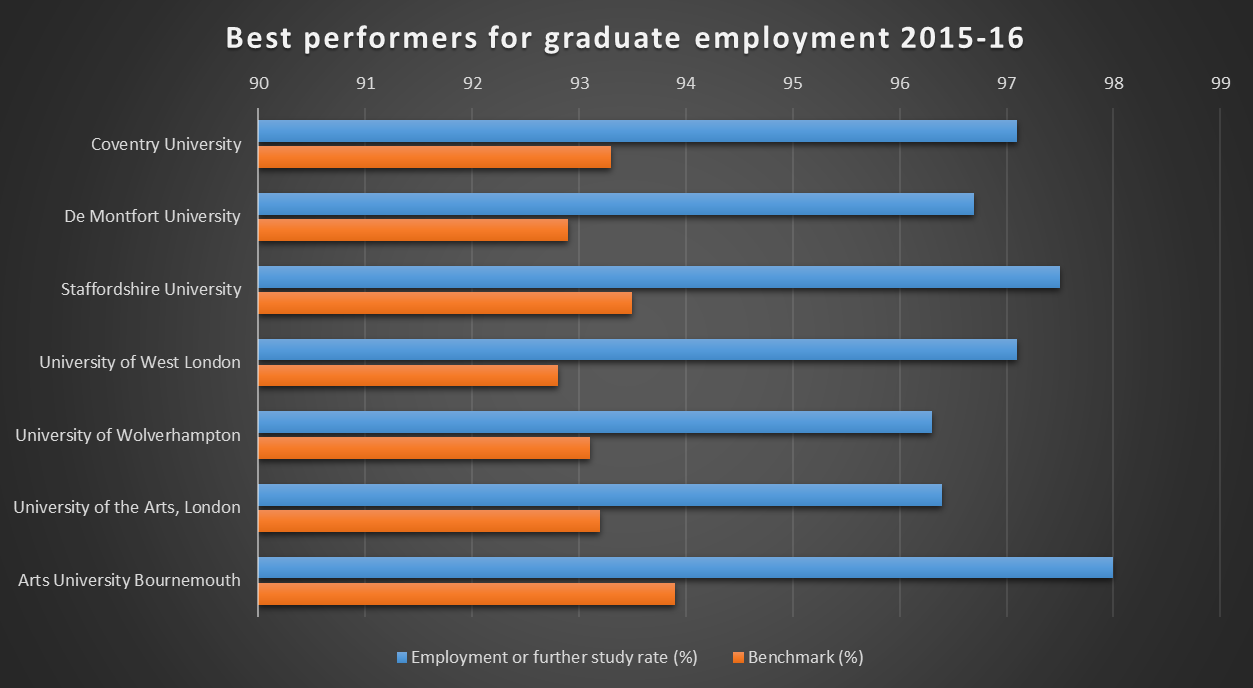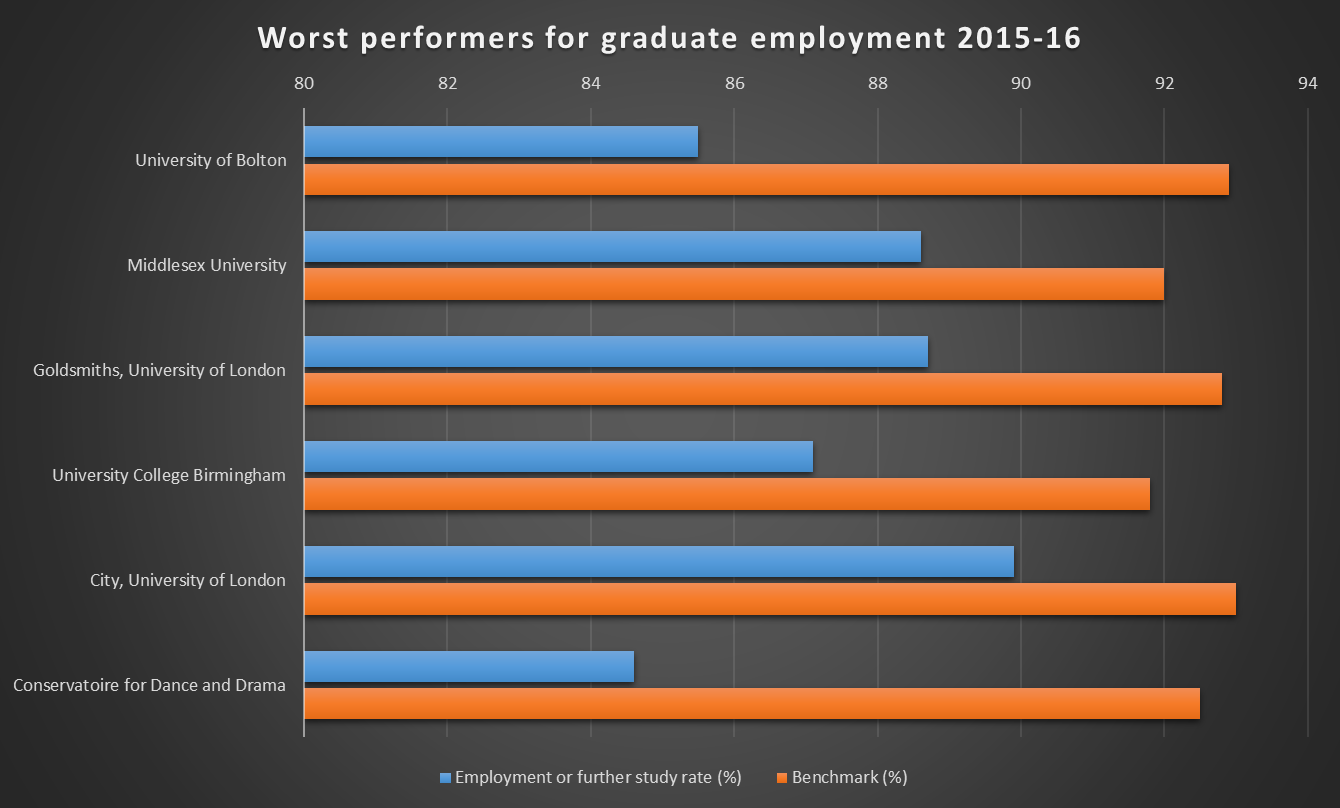The latest data on graduate employment rates by university may give hope to some institutions that a relatively poor performance in the teaching excellence framework (TEF) could improve in the years to come.
According to the most recent data from the Destination of Leavers from Higher Education (DLHE) survey, a number of institutions that scored badly in the TEF for graduate employment have seen good results in the share of their latest graduating cohort going on to jobs or further study, at least for full-time students who were taking a first degree.
The TEF used three years’ worth of data from the DLHE for the graduate employment metric, one of six used in the exercise, but it did not include the latest survey, which looked at the activity of 2015-16 graduates six months after they left university.
Many of the universities flagged by the Higher Education Statistics Agency (Hesa) as performing significantly above their benchmark for graduate employment in the latest survey were also those that did well in the TEF metrics (although the full-time TEF indicator looks at all students, not just first-degree graduates).
They include Coventry University (second in Times Higher Education’s TEF metrics ranking) and De Montfort University (the third-best performing university on the TEF employment metric in terms of distance from its benchmark).
However, one university with a marked difference compared with the TEF was Staffordshire University: 97.5 per cent of its graduates from last year were in work or further study compared with a benchmark of 93.5 per cent.


In 2014-15, Staffordshire had an employment or further study rate of 88.2 per cent – flagged as being significantly below its benchmark – while its performance in the TEF metric (based on data from 2012-13 and 2013-14 as well as 2014-15) was the third worst among all higher education institutions.
Sue Reece, pro vice-chancellor at Staffordshire, said that there were a number of factors behind the improvement on this year’s DLHE, including a better response rate to the survey ensuring that “we now have a more representative picture of how well our graduates are doing”.
“We also believe that our strategy to incorporate employability into all teaching modules is having a positive impact. In addition, we deliver a range of activities to support employability and enterprise including the option of a guaranteed work experience, volunteering and real-world projects.”
Universities such as Staffordshire that see such a turnaround in performance on any metrics used in the TEF may be encouraged to enter again next year. TEF awards last for three years, but institutions can apply again next year if they want a fresh assessment. Staffordshire itself gained a silver award in the TEF this time around.
A list of universities with markedly better scores for graduate employment in this year’s DLHE compared with the TEF – although the latter is based on a wider group of full-time students – suggests others that may be encouraged by an upturn.
Of the universities whose employment rate metric was below benchmark in the TEF and above benchmark in the latest DLHE, here are the 10 biggest movers in terms of their Z-score – a statistical measure of how far they were from their benchmark.
| Institution | Z-score for employment rate: 2015-16 DLHE | Z-score for employment rate: TEF |
| Staffordshire University | 8.33 | -11.10 |
| Southampton Solent University | 4.14 | -5.74 |
| London Metropolitan University | 3.06 | -5.55 |
| University of Portsmouth | 7.63 | -0.55 |
| Liverpool John Moores University | 0.51 | -5.70 |
| Writtle University College | 0.27 | -5.70 |
| London South Bank University | 2.64 | -2.55 |
| University of York | 2.39 | -1.62 |
| Rose Bruford College | 0.21 | -3.16 |
| Liverpool Hope University | 1.22 | -1.86 |
Source: Hesa/Hefce. Analysis by THE. Note: DLHE data are first-degree graduates only.
Among them are London Metropolitan University, the worst performer for universities across all metrics in the TEF, which could stand a chance of improving its lot in the exercise in future if the turnaround on graduate employment is sustained and replicated in other metrics.
Meanwhile, among universities that were above benchmark for employment outcomes in the TEF but below benchmark in the latest DLHE, these 10 saw the biggest difference in Z-score between the two indicators.
| Institution | Z-score for employment rate: 2015-16 DLHE | Z-score for employment rate: TEF |
| University of Surrey | -2.63 | 8.11 |
| University of Northampton | -0.83 | 8.82 |
| Conservatoire for Dance and Drama | -3.28 | 2.92 |
| Goldsmiths, University of London | -4.27 | 1.71 |
| University of Westminster | -4.21 | 1.59 |
| Aston University | -2.50 | 2.96 |
| Royal Agricultural University | -2.12 | 2.54 |
| Sheffield Hallam University | -4.17 | 0.35 |
| University of Gloucestershire | -0.78 | 3.72 |
| University of Cambridge | -0.20 | 4.19 |
Source: Hesa/Hefce. Analysis by THE. Note: DLHE data are first-degree graduates only.
Among them are gold TEF award winners such as the University of Surrey, although a note in the Hesa data explained that the institution had “made an error…causing 186 nursing students to be omitted from the DLHE return, which will have affected the indicator”.
Also, for any “gold” universities that do have poor graduate outcome statistics this year, their three-year TEF award means that they have plenty of time to try to improve their position before having to reapply again.
Find out more about THE DataPoints
THE DataPoints is designed with the forward-looking and growth-minded institution in view
Register to continue
Why register?
- Registration is free and only takes a moment
- Once registered, you can read 3 articles a month
- Sign up for our newsletter
Subscribe
Or subscribe for unlimited access to:
- Unlimited access to news, views, insights & reviews
- Digital editions
- Digital access to THE’s university and college rankings analysis
Already registered or a current subscriber?




